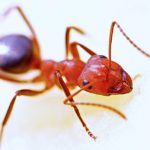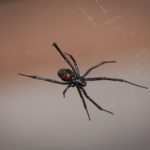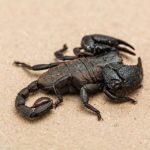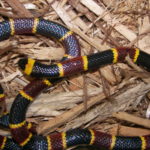
Most stings or bites from an insect or spider will often cause minor swelling, redness, itching, and pain around the site. Some people are more sensitive and can experience an allergic reaction to stings and bites such as hives, rash, itchy palms and feet, swollen or itchy eyes, swelling of lips or throat, headache, dizziness, nausea/vomiting, fast heart rate, and difficulty breathing. If you are experiencing an allergic reaction, go to the nearest hospital or doctor right away and be sure to hire a pest control company like the pest control company boise.
Ants & Fire Ants

- Most people who are stung will have redness, itching, swelling and some pain around the sting site
- If an allergic reaction occurs go to the nearest hospital
- Do not disturb or stand near ant mounds
- Check your surroundings
- Wash the site with soap and water
- Apply ice to reduce any swelling and pain
- Apply an anti-itch product
- Call the Georgia Poison Center at 1-800-222-1222 for treatment advice
Bees, Wasps, Hornets and Yellow Jackets

- Most people who are stung will have redness, itching, swelling and some pain around the sting site
- Some people may get hives, rash, itching palms and feet
- Others may experience headache, dizziness, nausea, vomiting or difficulty breathing (if you have any of these symptoms, go to the nearest hospital or doctor right away)
- Wear light colored, long sleeve shirts and pants
- Avoid perfumed soaps, shampoo, and deodorants
- Use insect repellents
- If a stinger is present, remove it by gently scraping across it with a flat object. Do not pinch the stinger or use tweezers, this may force venom (poison) into the skin
- Remove any jewelry near the site, as swelling may occur
- Wash the site with soap and water
- Apply ice to reduce any swelling and pain
- Call the Georgia Poison Center at 1-800-222-1222 for treatment advice
Black Widow Spider

- The bite of a black widow may be painful
- Within 1 hour after being bitten, you may experience stomach pain, dizziness, stiffness and have trouble breathing
- When camping, picnicking or engaging in other outdoor activities wear long pants, long sleeves, gloves and shoes
- Avoid walking in tall brush and shrubs
- Do NOT reach into rocky cracks, under logs or large rocks
- Apply insect repellent containing DEET to your clothing and sparingly to your skin (always read the label before using)
- Before dressing shake out clothing, shoes and hats that have not been worn for awhile
- Get rid of clutter in basements, closets, attics and garages
- Dust and vacuum around windows, corners of rooms, under furniture and in storage areas regularly
- Wash the bite site with soapy water
- Apply ice to reduce swelling and pain
- Call the Georgia Poison Center at 1-800-222-1222 right away for more treatment advice
Brown Recluse Spider

- The bite of a brown recluse may be very painful.
- Within 36 hours after being bitten, you may experience restlessness, fever, chills, nausea, weakness and joint pain.
- A “bulls-eye” like blister or wound may develop at the bite site. If the wound is not treated by a doctor, it may get larger.
- When camping, picnicking or engaging in other outdoor activities wear long pants, long sleeves, gloves and shoes
- Avoid walking in tall brush and shrubs
- Do NOT reach into rocky cracks, under logs or large rocks
- Apply insect repellent containing DEET to your clothing and sparingly to your skin (always read the label before using)
- Before dressing shake out clothing, shoes and hats that have not been worn for awhile
- Get rid of clutter in basements, closets, attics and garages
- Dust and vacuum around windows, corners of rooms, under furniture and in storage areas regularly
- Wash the bite site with soapy water
- Apply ice to reduce swelling and pain
- Call the Georgia Poison Center at 1-800-222-1222 right away for more treatment advice
Saddleback Caterpillars

- If your skin comes in contact with the caterpillar, fine hairs on its body may inject venom (poison) into your skin. The sting can be very painful and the pain will last until the hairs are removed.
- People may experience itching, burning, or a severe allergic reaction. (If an allergic reaction occurs go to the nearest hospital)
- Wear protective clothing and gloves
- Avoid any contact with one
- Remove the fine hairs by gently touching the sting site with a piece of scotch tape. Do not use the same piece of tape twice.
- Wash the sting site with soapy water
- Apply ice to reduce the stinging sensation followed by paste of baking soda and water
- If you are stung and feel a burning pain, have swelling, nausea, headache or weakness, go to the nearest hospital or doctor right away. You may be having an allergic reaction.
- Call the Georgia Poison Center at 1-800-222-1222 for more treatment advice
Scorpions

- The sting of a scorpion is like the sting of a bee or wasp
- May experience stinging or a burning sensation
- Symptoms usually subside within 48 hours
- Wear long sleeves and pants
- Wear leather gloves
- Shake out clothing or shoes before putting them on
- Wash the site with soap and water
- Apply ice to reduce swelling and pain
- Call the Georgia Poison Center at 1-800-222-1222 for treatment advice
Ticks

- Rash, chills, joint and muscle pain, cough, headache, and diarrhea
- Wear light colored clothing to help spot ticks
- Wear long sleeves and pants tucked into your socks or boots
- Apply insect repellent containing DEET to your clothing and sparingly to your skin (always read the label before using)
- After being outdoors check your body and hair for ticks
- Protect your pets by using flea and tick sprays, collars or medication
- Remove the tick by using a thin-tipped tweezers and grasping it as close to the skin surface as possible. Pull upward with a steady pressure, remove the entire tick and flush down the toilet
- Wash the area with soap and water once the tick is removed
- Call the Georgia Poison Center at 1-800-222-1222 for more treatment advice
Snakes
Snakes can be found everywhere in the state of Georgia. Snakes are territorial and will attack if they feel threatened. While most snakes in Georgia are nonvenomous, there are 6 that are venomous.

- Common Symptoms: swelling, pain, bruising, weakness, shock, nausea, vomiting and metallic taste in the mouth
- First Aid: Do NOT use a tourniquet or attempt to restrict blood flow to the area; Do NOT cut the wound or attempt to suck out the venom; Do NOT apply ice or heat. Remove jewelry and tight clothing near the bite. Keep the bitten limb below heart level. Stay calm and go to your nearest emergency department

- Common Symptoms: swelling, pain, bruising, weakness, shock, nausea, vomiting and metallic taste in the mouth
- First Aid: Do NOT use a tourniquet or attempt to restrict blood flow to the area; Do NOT cut the wound or attempt to suck out the venom; Do NOT apply ice or heat. Remove jewelry and tight clothing near the bite. Keep the bitten limb below heart level. Stay calm and go to your nearest emergency department

- Common Symptoms: swelling, pain, bruising, weakness, shock, nausea, vomiting and metallic taste in the mouth
- First Aid: Do NOT use a tourniquet or attempt to restrict blood flow to the area; Do NOT cut the wound or attempt to suck out the venom; Do NOT apply ice or heat. Remove jewelry and tight clothing near the bite. Keep the bitten limb below heart level. Stay calm and go to your nearest emergency department

- Common Symptoms: swelling, pain, bruising, weakness, shock, nausea, vomiting and metallic taste in the mouth
- First Aid: Do NOT use a tourniquet or attempt to restrict blood flow to the area; Do NOT cut the wound or attempt to suck out the venom; Do NOT apply ice or heat. Remove jewelry and tight clothing near the bite. Keep the bitten limb below heart level. Stay calm and go to your nearest emergency department

- Common Symptoms: swelling around the bite site that spreads, nausea and vomiting
- First Aid: Do NOT use a tourniquet or attempt to restrict blood flow to the area; Do NOT cut the wound or attempt to suck out the venom; Do NOT apply ice or heat. Stay calm and go to your nearest emergency department

- Common Symptoms: paralysis, swelling, pain, bruising, weakness, shock, nausea, vomiting and metallic taste in the mouth
- First Aid: Do NOT use a tourniquet or attempt to restrict blood flow to the area; Do NOT cut the wound or attempt to suck out the venom; Do NOT apply ice or heat. Remove jewelry and tight clothing near the bite. Keep the bitten limb below heart level. Stay calm and go to your nearest emergency department
- When camping, picnicking or engaging in other outdoor activities, wear long pants, long sleeves, gloves, and shoes; avoid walking in tall brush and shrubs
- Wear shoes and heavy pants when walking and hiking in areas where snakes are likely to be found
- Do not reach into rocky cracks, under logs, or large rocks
- Do not touch a snake, even if a snake looks dead. A snake can still bite up to one hour after its death.
- Do not tease a snake
- Listen for hissing or rattling sounds as this can be a warning that you are irritating a snake

